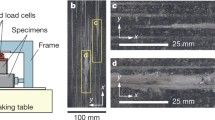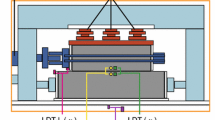Abstract
We describe experiments in which large (14×40 cm nominal contact area) blocks of gabbro were sheared in a direct shear apparatus at room temperature, 5 MPa normal stress, and slip velocities from 0.1 to 10 μm/s. The apparatus was servocontrolled using a displacement feedback measurement made directly between the gabbro blocks. Two surface roughnesses were studied (rough, produced by sandblasting, and smooth, produced by lapping with #60 grit) and accumulated displacements reached 60 mm. Measurements of surface topography were used to characterize roughness and asperity dimensions. Step changes in loading velocity were used to interrogate friction constitutive properties. Both rough and smooth surfaces showed appreciable displacement hardening. The coefficient of friction μ for rough surfaces was about 0.45 for initial slip and 0.7 after sliding 50 mm. Smooth surfaces exhibited higher μ and a greater tendency for unstable slip. The velocity dependence of frictiona−b and the characteristic friction distanceD c show systematic variations with accumulated displacement. For rough surfacesa−b started out positive and became negative after about 50 mm displacement andD c increased from 1 to 4 μm over the same interval. For smooth surfaces,a−b began negative and decreased slightly with displacement andD c was about 2 μm, independent of displacement. For displacements <30 mm, rough surfaces exhibit a second state variable with characteristic distance about 20 μm. The decrease ina−b with displacement is associated with disappearance of the second state variable. Our data indicate thatD c is controlled by surface roughness in a complex way, including but not limited to the effect of roughness on contact junction dimensions for bare rock surfaces. The data show that simple descriptions of roughness, such as rms and peak-to-trough, are not sufficient to inferD c . Our observations are consistent with a model in whichD c scales with gouge thickness.
Similar content being viewed by others
References
Archard, J. F. (1957),Elastic Deformation and the Laws of Friction, Proc. R. Soc. London, Ser. A243, 190–205.
Aki, K. (1957),Magnitude-frequency Relation for Small Earthquakes: A Clue to the Origin of f max of Large Earthquakes, J. Geophys. Res.92, 1349–1355.
Biegel, R. L., Sammis, C. G., andDieterich, J. H. (1989),The Frictional Properties of a Simulated Gouge Having a Fractal Particle Distribution, J. Struc Geology11, 827–846.
Beeler, N. M., Tullis, T. E., andWeeks, J. D. (1993),The Contribution of Simulated Gouge to the Velocity Dependence of Experimental Granite Faults, EOS, Trans. Amer. Geophys. Un.74, 296.
Blanpied, M. L., andTullis, T. E. (1986),The Stability and Behavior of a Frictional System with a Two State Variable Constitutive Law, Pure and Appl. Geophys.124, 415–430.
Blanpied, M. L., Lockner, D. A., andByerlee, J. D. (1991),Fault Stability Inferred from Granite Sliding Experiments at Hydrothermal Conditions, Geophys. Res. Lett.18, 609–612.
Chester, F. M. (1994),Effects of Temperature on Friction: Constitutive Equations and Experiments with Quartz Gouge, J. Geophys. Res.99, 7247–7261.
Cox, S. J. D.,Velocity dependent friction in a large direct shear experiment on gabbro. InDeformation Mechanisms, Rheology, and Tectonics (eds. Knipe, R. J, and Rutter, E.H.) (Geol. Soc. London 1990) Spec. Pub.54, pp. 63–70.
Dieterich, J. H. (1979),Modeling of Rock Friction: 1. Experimental Results and Constitutive Equations, J. Geophys. Res.84, 2161–2168.
Dieterich, J. H.,Constitutive properties of faults with simulated gouge. InMechanical Behavior of Crustal Rocks (eds. Carter, N. L., Friedman, M., Logan, J. M., and Stearns, D. M.) (AGU Monograph24, 1981) pp. 103–120.
Dieterich, J. H.,A model for the nucleation of earthquake slip. InEarthquake Source Mechanics (eds. Das, S.,Boatwright, J., andScholz, C H.) (AGU Monograph37, 1986) pp. 37–47.
Gu, Y., andWong, T.-f. (1994),Development of Shear Localization in Simulated Quartz Gouge: Effect of Cumulative Slip and Gouge Particle Size, Pure and Appl. Geophys.143, 387–423.
Ida, Y. (1973),The Maximum Ground Acceleration of Seismic Ground Motion. Bull. Seismol. Soc. Am.63, 959–968.
Kuwahara, Y., Ohnaka, M., Yamamoto, K., andHirasawa, T. (1988),Accelerating Process of Rupture Propagation during Stick-slip Failure Instability, Seis. Res. Lett.59, 2.
Li, V. C.,Mechanics of shear rupture applied to earthquake zones. InFracture Mechanics of Rock (ed. Atkinson, B.) (Academic Press, London, 1987) pp. 351–428.
Lockner, D. A., Summers, R., andByerlee, J. D. (1986),Effects of Temperature and Sliding Rate on Frictional Strength of Granite, Pure and Appl. Geophys.124, 445–469.
Marone, C. (1993),Micromechanics of Rate- and State-dependent Friction in Simulated Fault Gouge, EOS, Trans. Amer. Geophys. Un.74, 296.
Marone, C., andScholz, C. H. (1988),The Depth of Seismic Faulting and the Upper Transition from Stable to Unstable Slip Regimes, Geophys. Res. Lett.15, 621–624.
Marone, C., andKilgore, B. (1993),Scaling of the Critical Slip Distance for Seismic Faulting with Shear Strain in Fault Zones, Nature362, 618–621.
Marone, C., Raleigh, C. B., andScholz, C. H. (1990),Frictional Behavior and Constitutive Modeling of Simulated Fault Gouge., J. Geophys. Res.95, 7007–7025.
Marone, C., Hobbs, B. E., andOrd, A. (1992),Coulomb Constitutive Laws for Friction: Contrasts in Frictional Behavior for Distributed and Localized Shear, Pure and Appl. Geophys.139, 195–214.
Ohnaka, M., andYamashita, T. (1989),A Cohesive Zone Model for Dynamic Shear Faulting Based on Experimentally Inferred Constitutive Relation and Strong Motion Source Parameters, J. Geophys. Res.94, 4089–4104.
Ohnaka, M., andKuwahara, Y. (1990),Characteristic Features of Local Breakdown near a Crack-tip in the Transition Zone from Nucleation to Dynamic Rupture during Stick-slip Shear Failure, Tectonophys.175, 197–220.
Okubo, P. G. (1989),Dynamic Rupture Modeling with Laboratory-derived Constitutive Relations, J. Geophys. Res.94, 12,321–12,335.
Okubu, P. G., andDieterich, J. H. (1984),Effects of Physical Fault Properties on Frictional Instabilities Produced on Simulated Faults, J. Geophys. Res.89, 5817–5827.
Pisarenko, D., andMora, P. (1994),Velocity Weakening in a Dynamical Model of Friction, Pure and Appl. Geophys.143, 61–87.
Power, W. L., andTullis, T. E. (1992),The Contact between Opposing Fault Surfaces at Dixie Valley, Nevada, and Implications for Fault Mechanics, J. Geophys. Res.97, 14,425–14,435.
Press, W. H., Flannery, B. P., Teukolshy, S. A., andVetterling, W. T.,Numerical Recipes in C (Cambridge, 1988) 475 pp.
Rabinowicz, E. (1951),The Nature of the Static and Kinetic Coefficients of Friction, J. Appl. Phys.22, 1373–1379.
Reinen, L. A., andWeeks, J. D. (1993),Determination of Rock Friction Constitutive Parameters using an Iterative Least-squares Inversion Method. J. Geophys. Res.98, 15,937–15,950.
Reinen, L. A., Weeks, J. D., andTullis, T. E. (1991),The Frictional Behavior of Serpentinite: Implications for Aseismic Creep on Shallow Crustal Faults, Geophys. Res. Lett.18, 1921–1924.
Reinen, L. A., Weeks, J. D., andTullis, T. E. (1994),The Frictional Behavior of Lizardite and Antigorite Serpentinites: Experiments, Constitutive Models, and Implications for Natural Faults, Pure and Appl. Geophys.143, 317–358.
Rice, J. R. (1993),Spatio-temporal Complexity of Slip on a Fault, J. Geophys. Res.98, 9885–9907.
Rice, J. R., andRunia, A. L. (1983),Stability of Steady Frictional Slipping, J. Appl. Mech.50, 343–349.
Rice, J. R., andTse, S. T. (1986),Dynamic Motion of a Single Degree of Freedom System Following a Rate and State-dependent Friction Law., J. Geophys. Res.91, 521–530.
Ruina, A. (1983),Slip Instability and State Variable Friction Laws, J. Geophys. Res.88, 10359–10370.
Sammis, C. G., andSteacy, S. (1994),The Micromechanics of Friction in a Granular Layer, Pure and Appl. Geophys.142, 777–794.
Scholz, C. H. (1988),The Critical Slip Distance for Seismic Faulting, Nature336, 761–763.
Scholz, C. H.,The Mechanics of Earthquakes and Faulting (Cambridge University Press, 1990) 439 pp.
Tse, S. T., andRice, J. R. (1986),Crustal Earthquake Instability in Relation to the Depth Variation of Frictional Slip Properties, J. Geophys. Res.91, 9452–9472.
Tullis, T. E. (1988),Rock Friction Constitutive Behavior from Laboratory Experiments and its Implications for an Earthquake Prediction Field Monitoring Program, Pure and Appl. Geophys.126, 555–588.
Tullis, T. E., andWeeks, J. D. (1986),Constitutive Behavior and Stability of Frictional Sliding of Granite, Pure and Appl. Geophys.124, 383–414.
Wang, W., andScholz, C. H. (1994),Micromechanics of the Velocity and Normal Stress Dependence of Rock Friction, Pure and Appl. Geophys.143, 303–315.
Wesnousky, S. G. (1990),Seismicity as a Function of Cumulative Geologic Offset: Some Observations from Southern California, Bull. Seismol. Soc. Am.80, 1374–1381.
Wong, T.-f., Gu, Y., Yanagidani, T., andZhao, Y.,Stabilization of faulting by cumulative slip. InFault Mechanics and Transport Properties of Rock (eds. Evans, B., and Wong, T.-f.) (Academic Press Ltd., 1992) pp. 119–143.
Yamada, K., Takeda, N., Kagami, J., andNaoi, T. (1978),Surface Density of Asperities and Real Distribution of Asperity Heights on Rubbed Surfaces, Wear47, 5–20.
Yoshioka, N., andScholz, C. H. (1989),Elastic Properties of Contacting Surfaces under Normal and Shear Loads 1. Theory., J. Geophys. Res.94, 17,681–17,690.
Author information
Authors and Affiliations
Rights and permissions
About this article
Cite this article
Marone, C., Cox, S.J.D. Scaling of rock friction constitutive parameters: The effects of surface roughness and cumulative offset on friction of gabbro. PAGEOPH 143, 359–385 (1994). https://doi.org/10.1007/BF00874335
Received:
Revised:
Accepted:
Issue Date:
DOI: https://doi.org/10.1007/BF00874335




